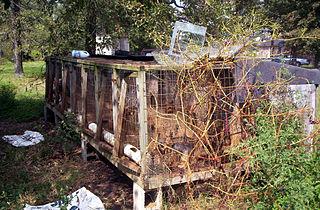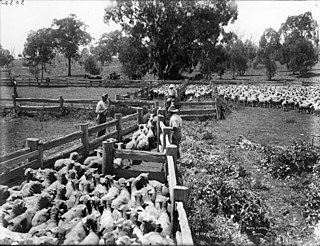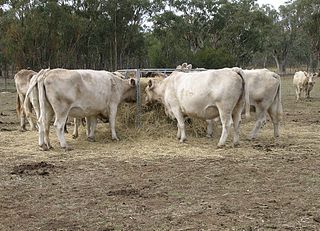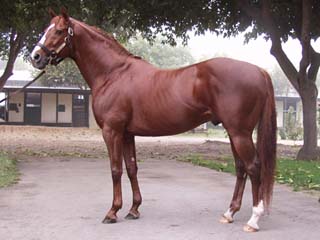Animal breeding may refer to:
- Animal breeding, the breeding of animals by humans
- Breeding in the wild
Animal breeding may refer to:

The Bengal cat is a breed of hybrid cat created from crossing of an Asian leopard cat, with domestic cats, especially the spotted Egyptian Mau. It is then usually bred with a breed that demonstrates a friendlier personality, because after breeding a domesticated cat with a wildcat, its friendly personality may not manifest in the kitten. The breed's name derives from the leopard cat's taxonomic name.

Selective breeding is the process by which humans use animal breeding and plant breeding to selectively develop particular phenotypic traits (characteristics) by choosing which typically animal or plant males and females will sexually reproduce and have offspring together. Domesticated animals are known as breeds, normally bred by a professional breeder, while domesticated plants are known as varieties, cultigens, cultivars, or breeds. Two purebred animals of different breeds produce a crossbreed, and crossbred plants are called hybrids. Flowers, vegetables and fruit-trees may be bred by amateurs and commercial or non-commercial professionals: major crops are usually the provenance of the professionals.

A puppy mill, also known as a puppy farm, is a commercial dog breeding facility characterized by quick breeding and poor conditions. Although no standardized legal definition for "puppy mill" exists, a definition was established in Avenson v. Zegart in 1984 as "a dog breeding operation in which the health of the mill’s dogs is disregarded to maintain a low overhead and maximize profits". They are cited as being a result of increased demand for household pets, especially after World War II. The Veterinary Medical Association of the Humane Society of the United States defines the main characteristics of a puppy mill as "emphasis on quantity over quality, indiscriminate breeding, continuous confinement, lack of human contact and environmental enrichment, poor husbandry, and minimal to no veterinary care."
Pedigree may refer to:
Breeding is sexual reproduction that produces offspring, usually animals or plants. It can only occur between a male and a female animal or plant.
A crossbreed is an organism with purebred parents of two different breeds, varieties, or populations. Crossbreeding, sometimes called "designer crossbreeding", is the process of breeding such an organism. While crossbreeding is used to maintain health and viability of organisms, irresponsible crossbreeding can also produce organisms of inferior quality or dilute a purebred gene pool to the point of extinction of a given breed of organism.

Captive breeding, also known as captive propagation, is the process of keeping plants or animals in controlled environments, such as wildlife reserves, zoos, botanic gardens, and other conservation facilities. It is sometimes employed to help species that are being threatened by the effects of human activities such as climate change, habitat loss, fragmentation, overhunting or fishing, pollution, predation, disease, and parasitism.

Culling is the process of segregating organisms from a group according to desired or undesired characteristics. In animal breeding, it is removing or segregating animals from a breeding stock based on a specific trait. This is done to exaggerate desirable characteristics, or to remove undesirable characteristics by altering the genetic makeup of the population. For livestock and wildlife, culling often refers to killing removed animals based on their characteristics, such as their sex or species membership, or as a means of preventing infectious disease transmission.
Animal breeding is a branch of animal science that addresses the evaluation of the genetic value of livestock. Selecting for breeding animals with superior EBV in growth rate, egg, meat, milk, or wool production, or with other desirable traits has revolutionized livestock production throughout the entire world. The scientific theory of animal breeding incorporates population genetics, quantitative genetics, statistics, and recently molecular genetics and is based on the pioneering work of Sewall Wright, Jay Lush, and Charles Henderson.

A stud animal is a registered animal retained for breeding. The terms for the male of a given animal species usually imply that the animal is intact—that is, not castrated—and therefore capable of siring offspring. A specialized vocabulary exists for de-sexed animals and those animals used in grading up to a purebred status.

A stallion is a male horse that has not been gelded (castrated). Stallions follow the conformation and phenotype of their breed, but within that standard, the presence of hormones such as testosterone may give stallions a thicker, "cresty" neck, as well as a somewhat more muscular physique as compared to female horses, known as mares, and castrated males, called geldings.
Animal sexes may refer to:

A stud farm or stud in animal husbandry is an establishment for selective breeding of livestock. The word "stud" comes from the Old English stod meaning "herd of horses, place where horses are kept for breeding". Historically, documentation of the breedings that occur on a stud farm leads to the development of a stud book. Male animals made available for breeding to outside female animals are said to be "standing at stud", or at "stud service", referencing the relatively high probability that they are kept at a stud farm.
Genetic erosion is a process where the limited gene pool of an endangered species diminishes even more when reproductive individuals die off before reproducing with others in their endangered low population. The term is sometimes used in a narrow sense, such as when describing the loss of particular alleles or genes, as well as being used more broadly, as when referring to the loss of a phenotype or whole species.

A dwarf cat is a domestic cat with dwarfism due to rare genetic mutations causing a disproportionate feline body and significant health problems. Unlike undersized cats of normal proportions, dwarf cats suffer from the genetic mutations osteochondrodysplasia and achondroplasia. These genetic disorders of bone and cartilage are typically manifested as abnormal bone shape, poor growth or lack of growth, bowing of the limbs to the side – front legs are more likely to be affected, and spinal malformations.
Foundation stock or foundation bloodstock refers to animals that are the progenitors, or foundation, of a breed or of a given bloodline within such. Many modern breeds can be traced to specific, named foundation animals, but a group of animals may be referred to collectively as foundation bloodstock when one distinct population provides part of the underlying genetic base for a new distinct population.

The Thoroughbred is a horse breed developed for horse racing. Although the word thoroughbred is sometimes used to refer to any breed of purebred horse, it technically refers only to the Thoroughbred breed. Thoroughbreds are considered "hot-blooded" horses that are known for their agility, speed, and spirit.

An endangered species is a species that is very likely to become extinct in the near future, either worldwide or in a particular political jurisdiction. Endangered species may be at risk due to factors such as habitat loss, poaching, and invasive species. The International Union for Conservation of Nature (IUCN) Red List lists the global conservation status of many species, and various other agencies assess the status of species within particular areas. Many nations have laws that protect conservation-reliant species which, for example, forbid hunting, restrict land development, or create protected areas. Some endangered species are the target of extensive conservation efforts such as captive breeding and habitat restoration.
Godrej Agrovet Limited is an Indian company which operates in the animal feed and agribusiness sectors. The company, which is part of the highly diversified Godrej Group, had a turnover of around Rs. 3100 Cr in FY 2012–13. Godrej Agrovet's chairman is Nadir Godrej. The company's subsidiary, Astec LifeSciences, manufactures agrochemicals.
Cultivation may refer to: